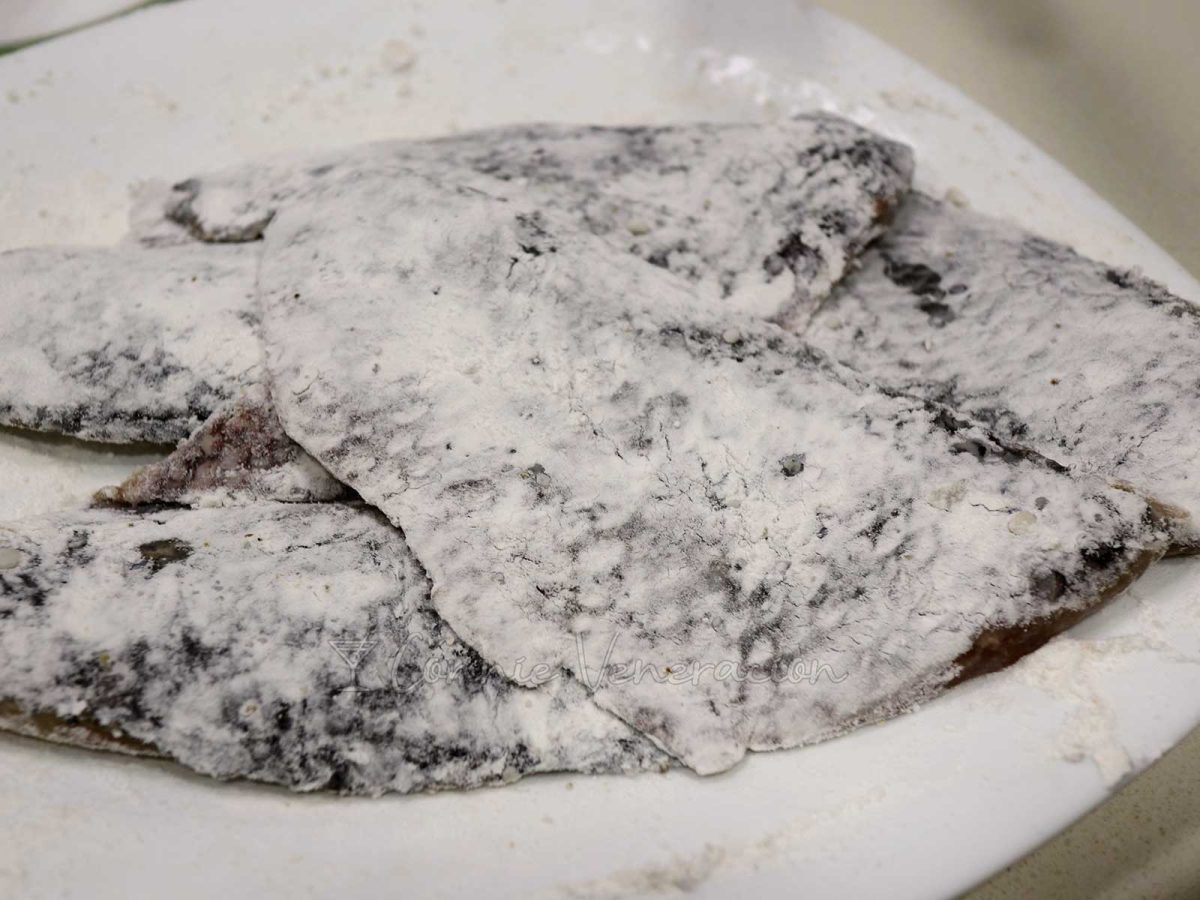Does it have to be dark beer? If you want the best results, yes. We’ve tried using pale pilsen but the result wasn’t as good. We’ve tried light beer and the result was so disappointing that we might as well have used plain water. So, for the best fish and chips, it’s dark beer.
There are four steps in cooking fish with a light crispy crust. But a tip here before we go into those four steps. If cooking the fish with the skin, score the skin a few times. This will prevent the fillet from curling during frying. Do this before everything else.
After scoring the fish skin, we go to the first step which is removing surface moisture. If you haven’t discovered it yet, moisture prevents fried food from acquiring a nice crisp crust. My trick is to prepare two stacks of paper towels. I arrange the fish fillets in a single layer on one stack, place the scond stack on top and press. With the surface moisture removed, the fish fillets are ready to be seasoned.

Place the fish fillets on a dry tray. Sprinkle your seasoning on both sides of the fish. Cover the tray and stick the fish in the fridge for 30 minutes. Why season the fish ahead if the batter is going to be seasoned anyway? Won’t the flavor of the batter be sufficient? The long and short answer is NO. If you want fish fillets that taste great all the way to the innermost part of the flesh, season them and give them time to soak up the flavors.

The second step is dredging the fish fillets in flour (we prefer a mixture of flour and starch). The batter will not stick to the fish well unless the surface of the fillets are coated with flour. Despite having removed the surface moisture from the fish, they will still be a bit wet. If you dip them in batter immediately, most of the batter will drip off before the fish reaches the hot oil. So, dredge in flour.

The third step is coating the fish with batter. When dipping the floured fish in batter, allow the excess to drip off. You want a light and crispy crust — definitely nothing as thick as bread.

The fourth step is frying. Fry the fish fillets in batches. How many pieces per batch depends on the size of the fillets and your frying pan. As a practical guide, the fillets shouldn’t touch one another during frying.
With all those tips, you shouldn’t have any problem cooking battered fish. Well, unless you’re the kind of reader who skips everything above the recipe box.
Fish and chips

Ingredients
Fish
- 6 fish fillets about 600 grams total weight (tilapia is used here)
- herb salt (or substitute plain salt and pepper)
To fry
- 2 to 3 cups cooking oil
- ⅓ cup all-purpose flour
- ⅓ cup potato starch
- ½ teaspoon baking powder
- ½ teaspoon salt
- ½ cup dark beer
To serve
- chips (fried potato wedges or substitute French fries)
- vinegar or lemon wedges
- lemon pepper seasoning (optional)
Instructions
Season the fish fillets
- Place the fish fillets between stacks of paper towels and press to remove surface moisture.
- Sprinkle both sides of the fish fillets with salt and pepper.
- Leave to marinate in the fridge.
Flour, dip in batter and fry the fish
- In a large frying pan, heat enough cooking oil to reach a depth of at least three inches.
- Take the fish out of the fridge.
- Whisk together the flour and potato starch.
- Take one-fourth cup of the flour-starch mixture and set aside.
- To the remaining flour-starch mixture, add the baking powder, salt and dark beer. Stir until smooth.
- Coat each fish fillet with the reserved flour-starch mixture.
- Dip each fish fillet in the batter and slide into the hot oil and cook until a deep golden crust forms (do this in batches if your pan is not very large).
- Rest the fried fish fillets on a rack.
Serve your fish and chips
- Place the fish and chips on plates.
- Optionally, sprinkle the fish with lemon pepper seasoning.
- Serve with vinegar or lemon wedges on the side.




